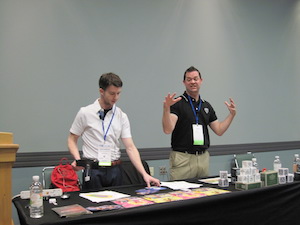FETC 2015 Coverage
Augmented Reality: Bringing a New Dimension to Learning
- By Patrick Peterson
- 01/23/15

Brad Waid, (right) and Drew Minock, co-founders of Two Guys and Some iPads, presented Thursday at FETC 2015, delivering a talk titled "Bring a New Dimenson to Learning with Augmented Reality."
If you're the kind of person who gets suspicious when learning becomes fun, just forget about the creators of "Two guys and Some iPads."
The bloggers, teachers, co-founders and enthusiastic showmen Brad Waid and Drew Minock brought their Two Guys Show to the FETC 2015 convention in Orlando, FL Thursday.
In a session called "Bring a New Dimension to Learning with Augmented Reality," the pair of award winning educators demonstrated how flat pages would come to 3D life with the help of an iPad and an augmented reality app. They ended the demonstration by throwing prizes into the audience that would help convert iPads into magical 3D devices.
It's a gimmick that works, said Dorothy Smay, a 43-year classroom veteran of elementary school.
"I know students all like this," said Smay, who attended the session and has used augmented reality in the classroom for several years. "Those kinds of things are very exciting for the children."
It's not just a gimmick or a distraction, Smay said. "Sometimes it's a kickstart. You have somebody who is not going to be as productive, and you start them them. Now that we hook them, we can do other things with them. It's a matter of how you use it. It's just like gaming. Are you gaming all day long? I'm not sure that's productive. Are you gaming to solve problems in your own life?"
Augmented reality is a technology that superimposes data (a text label, graphic or other element) over imagery of the real world as it's viewed through a computer, phone or tablet. The technology has huge educational potential because it allows teachers to generate excitement in students who, for example, are weary of looking at the periodic table of elements, which has hung unchanged for decades on classroom walls.
"It creates a whole new way of learning," said Waid, who appeared with Minock Thursday at the conference. The teacher's job is to turn that excitement into learning "When you're working with students, you know when you have a great lesson," Waid said.
After downloading the proper app, a teacher can point the video camera of an iPad or other tablet at a drawing and a virtual image materializes on the video screen, sometimes with narration. The virtual images interact with actual shapes in the video. The apps can be used to design homes, teach young students about dinosaurs or to learn about the human body with a detailed anatomy program.
Students are usually spellbound by the images that show up on the video screen.
"The excitement is contagious," Minock added. "No one has an awesome experience and doesn't tell anyone about it."
Minock said the augmented reality demonstrations give students, who have grown up learning about the world from video screens, a new view of the world that they are comfortable with.
"We use an app to explain everything and tie it right to the homework," he said. "Parents are trying to help students, but they're using an old vocabulary."
About the Author
Patrick Peterson worked for Florida Today, a Gannett daily newspaper in Brevard County, Fla., from 2005 through 2013, and earlier was embedded with U.S. Marines as a reporter during the 2003 invasion of Iraq. In Biloxi, Miss., he was a reporter for The Sun Herald newspaper and also founded and ran a charter boat company. He is a journalism graduate of Louisiana State University.